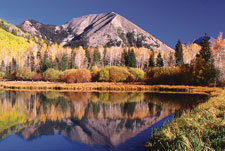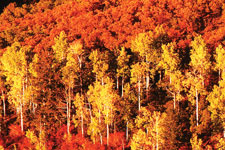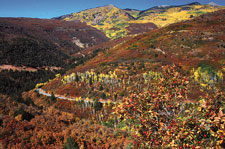 Fall color punctuates the transition from summer to autumn. Shorter days and cooler mornings also mark this change, but it is the leaf drop and color change that puts the exclamation mark on this season.
Fall color punctuates the transition from summer to autumn. Shorter days and cooler mornings also mark this change, but it is the leaf drop and color change that puts the exclamation mark on this season.
Of course, autumn is known as “fall” for the raining of deciduous leaves upon the Earth. We don’t call this season “leaf drop,” it just wouldn’t work poetically. Whatever term is used, late September and October are often gorgeous months in Canyon Country to enjoy this colorful display.
In the mountains, the aspen groves and deciduous shrubs erupt in color that rivals the blooming season. But instead of flowers, it is the leaves’ chance to shine.
Leaves contain various pigments that provide color and functions for the plant. Abundant chlorophyll pigments color the leaves green, while carotene and xanthophyll pigments produce orange and yellow colors. Present within the leaf, these two pigments are masked by the abundant chlorophyll. It generally takes the breaking down of the chlorophyll to expose these pigments. This happens in the fall, as the leaves begin to shut down their food producing abilities and the chlorophyll pigments break down. For deciduous trees this is a sort of hibernation period. So rt of.
rt of.
During the fall, the leaves also produce abscisic acid which will slow down production and eventually trigger cells that close off the connection between the leaf and the branch. When this happens, the leaves drop; and a season is named for their descent.
In addition to the above pigments, there are scarlet colors of red and purple that also comes from pigments, called anthocyanins. These pigments are not unmasked, but rather synthesized from leftover sugar compounds produced in the leaf. Hence, an ideal condition for red coloration requires sunny days with little overcast and cool autumn nights. During an unusually warm October, the trees may continue to use these sugars produced during the day for growth and not leave enough for the reds to develop. Cloudy or rainy weather also prevents the red pigments from forming, and can wash out the fall foliage. Of course, a few hard freezes will accelerate this transition and cause the tree to shed their leaves faster than discarded New Year resolutions.

Evergreens like ponderosa pine, subalpine fir, Engelmann spruce and Douglas fir retain their leaves through the winter. The needlelike leaves on the conifers also go through a cellular level process which increase solutes in the cells and lowers the tree’s freezing point. This process helps keep the cells from freezing and bursting. The trees also have a high density of needles per tree and a branching structure that helps increase temperatures and shed snow, respectively. Thus, the evergreens hold onto the leaves, but replace them at another time.
Locally, the La Sals, Abajos or Grand Mesa in Colorado are areas that put on a dazzling autumn show, but don’t forget about the canyons cloaked with cottonwoods and willows. The stunning contrast of red rock and golden leaves is spectacular, and extends the fall foliage season at these lower elevations. As the trees and shrubs shed their leaves, this is an ideal time to visit Canyon Country and take in some the autumn show.